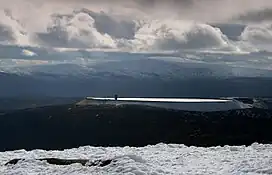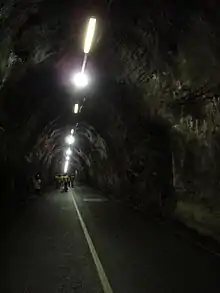| Turlough Hill (Cnoc an Turlaigh) | |
|---|---|
| Tomaneena (Tuaim an Aonaigh) | |
 The upper reservoir on Turlough Hill, viewed from Tonelagee | |
| Highest point | |
| Elevation | 681 m (2,234 ft)[1] |
| Prominence | 54 m (177 ft)[1] |
| Coordinates | 53°01′27″N 6°24′59″W / 53.02417°N 6.41639°W[1] |
| Geography | |
 Turlough Hill (Cnoc an Turlaigh) Location in Ireland | |
| Location | County Wicklow, Ireland |
| Parent range | Wicklow Mountains |
| OSI/OSNI grid | T063982 |
| Topo map | OSI Discovery No. 56 |
| Climbing | |
| Easiest route | Access road to north of summit |
Turlough Hill (Irish: Cnoc an Turlaigh, meaning 'Hill of the Turlach'),[2] also known as Tomaneena (Irish: Tuaim an Aonaigh, meaning 'mound of the assembly/fair'),[1] is a 681-metre-high (2,234 ft) mountain in County Wicklow in Ireland and site of Ireland's only pumped-storage hydroelectricity plant. The power station is owned and operated by the ESB and can generate up to 292 megawatts (392,000 hp) of electricity at times of peak demand.
The mountain


The historian Liam Price recorded that the mountain was known locally as Tomaneena;[3] Turlough Hill is the name given to it by the ESB when they surveyed the site for the pumped-storage scheme.[4] It is 681 metres (2,234 ft) high and is the 136th highest summit in Ireland.[1] The summit is located to the south-west of the upper reservoir and is easily reached via the tarmac access road that begins at the top of the Wicklow Gap.[5] It is also possible to reach the summit from Glendalough or from the summits of neighbouring Camaderry and Conavalla mountains.[6]
The underlying geology of the mountain is granite, covered with blanket bog, which is a habitat for heather, purple moor grass and sphagnum moss.[7] A number of alpine plants grow near the summit: dwarf willow, cowberry, crowberry, fir clubmoss and common bilberry.[8] To the north-east of the summit, at the head of Glendasan valley, is Lough Nahanagan (Irish: Loch na hOnchon, meaning 'Lake of the Water Monster'),[9] a corrie lake carved by a glacier at the end of the last ice age.[10]
The pumped-storage scheme

The Turlough Hill Power Station is owned and operated by the Electricity Supply Board (ESB).[11] Construction commenced in 1968, and the station became fully operational in 1974.
Name
Whilst the original name is Tomaneena, renaming it ‘Turlough Hill’ has a certain validity. The pumped storage station draws water from the mountain top lake, which thus becomes a ‘dry lake’. There is a geological feature known as a Turlough; it is defined as "(in Ireland) a low-lying area on limestone which becomes flooded in wet weather through the welling up of groundwater from the rock. Origin late 17th cent.: from Irish turloch, from tur ‘dry’ + loch ‘lake’."[12]
References
- 1 2 3 4 5 "Tomaneena". Mountain Views. Retrieved 21 July 2011.
- ↑ "Turlough Hill". Placenames Database of Ireland. Department of Culture, Heritage and the Gaeltacht. Retrieved 6 June 2020.
- ↑ Corlett & Weaver 2002, p. 310.
- ↑ Munro, Hugh (4 November 1968). "The development of electricity in Ireland". The Irish Times. Dublin. p. 18.
- ↑ Dillon 1993, pp. 37–38.
- ↑ Dillon 1993, p. 39.
- ↑ Kelly, Tony (15 February 1969). "£12m ESB scheme begun in Wicklow". The Irish Times. Dublin. p. 9.
- ↑ Winder, Frank (2001). "Viewing Points for Alpine Plants in Wicklow". The Irish Naturalists' Journal. 26 (12): 478–479.
- ↑ "Lough Nahanagan". Placenames Database of Ireland. Department of Culture, Heritage and the Gaeltacht. Retrieved 6 June 2020.
- ↑ Colhoun, E. A.; Synge, F. M. (1980). "The Cirque Moraines at Lough Nahanagan, County Wicklow, Ireland". Proceedings of the Royal Irish Academy. 80B: 25–45.
- ↑ "Power Stations: Turlough Hill". ESB Group. Archived from the original on 14 June 2011. Retrieved 22 July 2011.
- ↑ quoted directly from Apple Computer’s Oxford Dictionary of English 3rd edition, 2010. See also Whittow, John (1984) The Penguin Dictionary of Physical Geography, p.556.
Bibliography
- Corlett, Christiaan; Weaver, Mairéad, eds. (2002). The Liam Price Notebooks: The Placenames, Antiquities and Topography of Co. Wicklow. Vol. 1. Dublin: Dúchas. ISBN 0-7557-1284-6.
- Department of Communications, Energy and Natural Resources (2010). "National Renewable Energy Action Plan" (PDF). Archived from the original (PDF) on 16 October 2011. Retrieved 29 October 2011.
- Dillon, Paddy (1993). The Mountains of Ireland. Milnthorpe: Cicerone Press. ISBN 978-1-85284-110-2.
